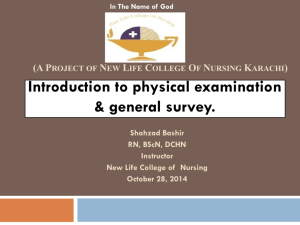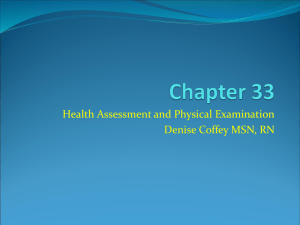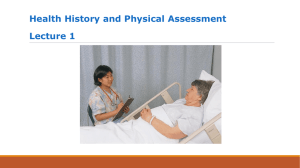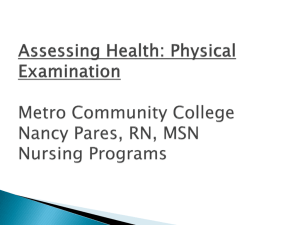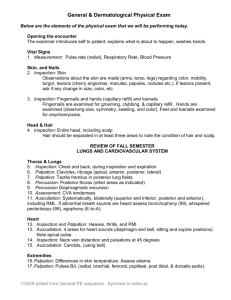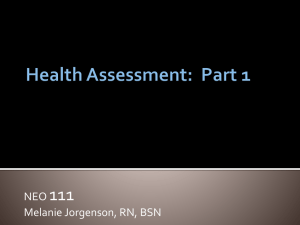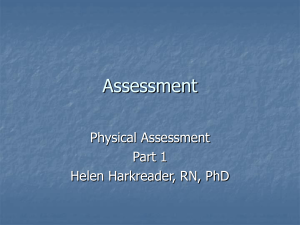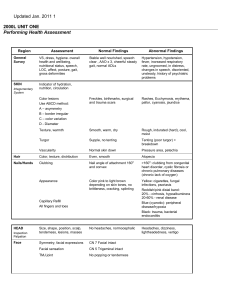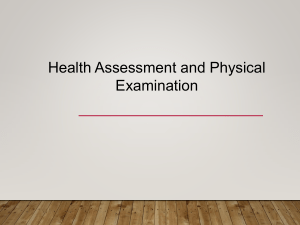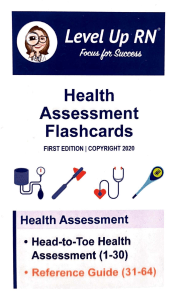Physical Examination (physical assessment). Purpose of physical examination;
advertisement
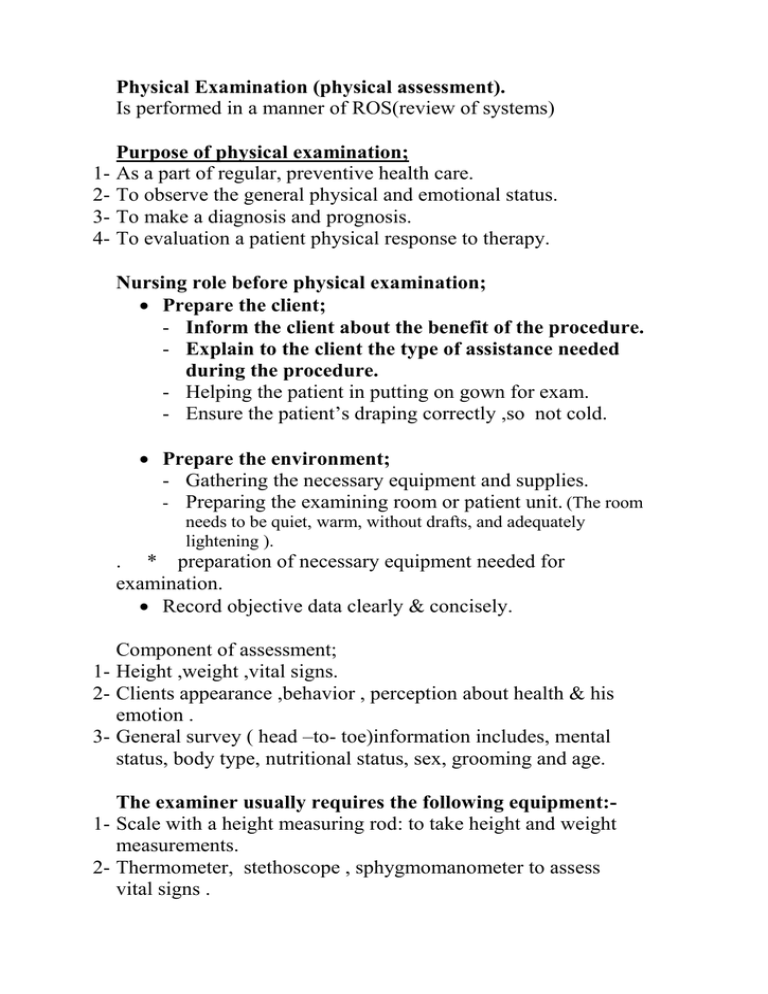
Physical Examination (physical assessment).
Is performed in a manner of ROS(review of systems)
Purpose of physical examination;
1- As a part of regular, preventive health care.
2- To observe the general physical and emotional status.
3- To make a diagnosis and prognosis.
4- To evaluation a patient physical response to therapy.
Nursing role before physical examination;
Prepare the client;
- Inform the client about the benefit of the procedure.
- Explain to the client the type of assistance needed
during the procedure.
- Helping the patient in putting on gown for exam.
- Ensure the patient’s draping correctly ,so not cold.
Prepare the environment;
- Gathering the necessary equipment and supplies.
- Preparing the examining room or patient unit. (The room
needs to be quiet, warm, without drafts, and adequately
lightening ).
. * preparation of necessary equipment needed for
examination.
Record objective data clearly & concisely.
Component of assessment;
1- Height ,weight ,vital signs.
2- Clients appearance ,behavior , perception about health & his
emotion .
3- General survey ( head –to- toe)information includes, mental
status, body type, nutritional status, sex, grooming and age.
The examiner usually requires the following equipment:1- Scale with a height measuring rod: to take height and weight
measurements.
2- Thermometer, stethoscope , sphygmomanometer to assess
vital signs .
3- an otoscope – for examining ears nose .
4- Ophthalmoscope ----to assess vision.
5- Bronchoscope ----to assess bronchi.
6- Tuning fork-- to assess hearing.
7- Laryngeal mirror and head mirror ---to examine the mouth
and throat.
8- A percussion hammer to test reflexes.
9- Tap measure
Skills of physical assessment .
1- Inspection – is the process of observation, to detact
body parts, normal characteristics, & physical sighs.
Ex; skill full nurse pay attention to clients movements, and
looking carefully to body parts , skin dryness & wrinkles.
To inspection body part accurately.
a- Make sure good lighting is available.
b- Position and expose body part.
c- Inspect each area for size , shape , color , symmetry ,
position and abnormalities.
d- Compare each area to be inspected with other side.
2-Palpation – assessment body parts through the sense of touch.
The hand can make delicate and sensitive measurement of
specific physical signs.
Types of palpitation ;
a- Light
b- Deep ,both types controlled by amount of pressure applied
by the fingers.
area examined by palpation
aSkin. temp, texture.
bOrgans {e.g. liver and intestine}.
cGlands thyroid and lymph.
dBlood vessels {e.g. carotid or femoral artery}
3- Percussion – taping the body with finger or strikingone
object with another to produce sound or vibration to aid in
diagnosis. Helpful in confirming other assessment finding
such as evaluate the size ,borders of the body cavity.
Types of percussion;
a- Direct ; striking body surface directly.
b- Indirect; the middle finger strikes the base of other
hand.
4-. Auscultation – is listen to sound created in body organs
to detected variations from normal ,by using the stethoscope .
Characteristics of sounds;
a- Frequency.
b- Loudness.
c- Quality.
d- Duration. or length of time that sound vibration lasts.
5- Olfaction – to detect abnormalities in nature of body odor
, infection , unfamiliar odor .
Position in physical examination:
Standing position {erect position –
Sitting position –
Supine position –
Sims position –
Knee – chest position – lithotomy position}.
Examination
The integumentary system (skin, hair, scalp, and nails) Inspect and
Palpate
Skin (Color,. Lesions, Moisture (wetness and oiliness) ,Temperature
,Mobility and turgor (elasticity), Dependent edema
Hair:
1. Quality, distribution, pattern of hair loss,
2. Texture and oiliness.
3. Body hair for amount
Scalp:
The scalp should be shiny and smooth(without lesios, lumps, or masses).
Nails
1. Note the nail color, shape, and texture. vascular with a pink color
,Angle between the fingernail and base is about 160°. When palpated the
nail base is firm.
Head and Neck
Areas to be included in the head and neck examination are the skull, face,
eyes, ears, nose, mouth, pharynx, and neck
Skull and Face
Assessment of the skull and face involves inspection and palpation. The
client’s face has its own unique characteristics influenced by factors such
as race, state of
health, emotions, and environment.
Eyes
The assessment of visual acuity is a simple, (is performed with the use of
a Snellen chart)
Ears
inspection and palpation of the external ear, and otoscopic assessment.
The nurse should observe the
client for signs of hearing difficulty during the physical examination,
Nose and Sinuses
Assessment is limited to inspection and palpation of the external nose and
nasal passages using a penlight. An examination with a nasal speculum to
inspect the nasal chambers palpate the frontal and maxillary sinuses for
tenderness, determine whether has had discharge, epistaxis, pain, or
difficulty smelling.
Mouth and Pharynx
Physical assessment of the oral cavity includes the breath, lips, tongue,
buccal mucosa, gums and teeth,
hard and soft palate, and pharynx. The oral cavity can yield significant
information regarding the lient’s health because systemic diseases may
manifest initially in the oral cavity. Ask if he's had tongue or gum
soreness, bleeding gums, taste or voice changes, a sore throat or difficulty
chewing or swallowing.
Neck
Physical examination of the neck includes the neck muscles, lymph nodes
of the head and neck, thyroid
gland, and trachea. The lymph nodes are normally not easily palpable. If
the client has an enlarged thyroid gland, the blood supply will be
increased, causing a fine vibration that can be auscultated with the
diaphragm of the stethoscope.
Thorax and Lungs
Physical assessment includes inspection, palpation, percussion, and
auscultation of the posterior, lateral, and anterior thorax and lungs for
accurate documentation of findings.
Respiratory auscultation reveals the presence of normal and abnormal
breath sounds. During auscultation, the client should be instructed to
breathe only through the mouth because mouth breathing decreases air
turbulence that could interfere with an accurate assessment. There are
three distinct types of normal breath sounds with their own unique pitch,
intensity, quality, location, and relative duration in the inspiratory and
expiratory phases of respiration:
• Vesicular sounds: soft, breezy, and low-pitched sounds heard longer
on inspiration than expiration
that result from air moving through the smaller airways over the lung’s
periphery, with the exception of
the scapular area
• Bronchovesicular sounds: medium-pitched and blowing sounds heard
equally on inspiration and expiration from air moving through the large
airways, posteriorly between the scapula and anteriorly over bronchioles
lateral to the sternum at the first and second intercostal spaces
• Bronchial sounds: loud and high-pitched sounds with a hollow quality
heard longer on expiration than inspiration from air moving through the
trachea
Heart and Vascular System
Heart and vascular system assessment techniques consist of inspection,
palpation, and auscultation. The nurse should review the client’s profile
relative to the health history for cardiac risk factors such as family
history, cigarette smoking, and dietary and exercise habits.
Breast and axillae: Stand in front of patient, examine her breasts- first
with her arms relaxed, then with her arms elevated and , finally with her
hands on her hips. With the patient lying down, palpate the axillary
nodes. Has patient had pain, swelling, lumps, breast tenderness, nipple
changes, or discharge?
Cardiovascular system: Inspect and palpate carotid pulsations, and
auscultation for carotid bruits. Then elevate the bed about 30 degrees,
observe jugular venous pulsation, and measure jugular venous pressure,
assess the apical impulse.
Abdomen: With the patient supine and the head of the bed flat, inspect,
auscultate, palpate, and percuss the abdomen. Palpate lightly, then deeply,
to assess the liver, spleen, kidney, and aorta. Ask about pain, dysphagia,
nausea, vomiting, diarrhea, and hematemesis.
-Legs: Observe the muscle mass of the legs, varicose vein, ask him about
coldness, numbness, edema, or discoloration in the legs. With standing
examine the alignment of the legs. Palpate all pulses and inguinal lymph
nodes test rang of motion; ask about pain, cramping, stiffness.
